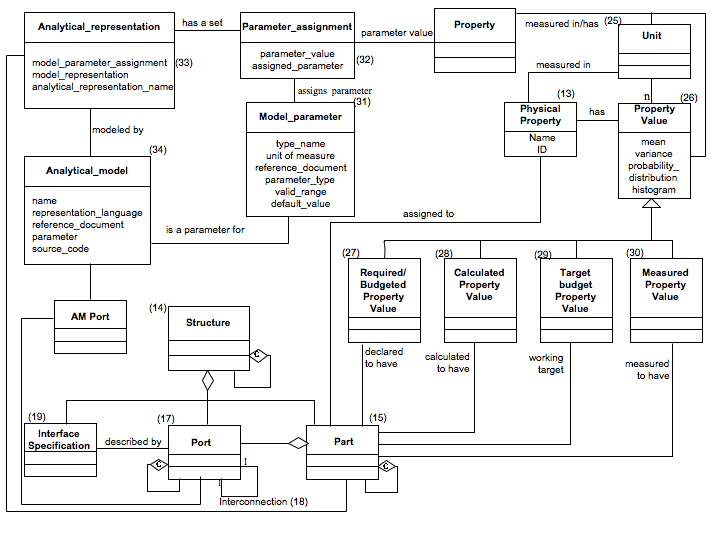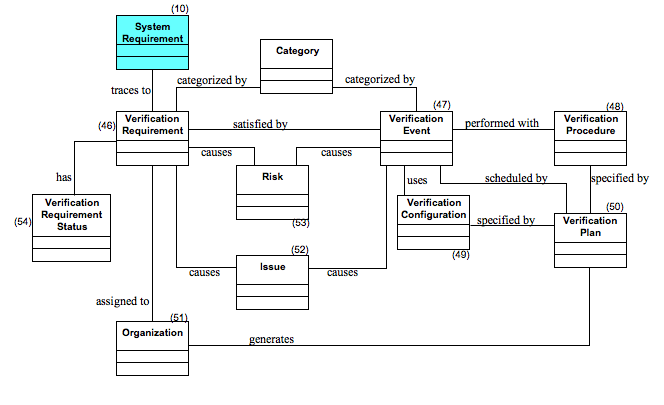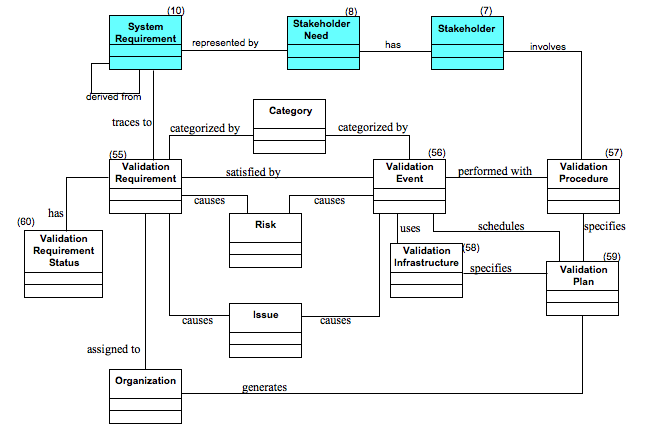|
|
Application module:
Decision support |
ISO/TS 10303-1486:2011-10(E)
© ISO
|
Implementations of this part of ISO 10303 shall make use of the capability to classify an
entity type using Classification_assignment (see ISO 10303-1114), Class (see ISO 10303-1070) and External_class (see ISO 10303-1275).
This annex contains a subclause for each entity type defined in or used by this part of ISO 10303 for which that capability
shall be applied. The specified Uniform Resource Identifier (URI) is used to identify each class.
NOTE-1 A URI can be a HTTP URI. However, the use of a HTTP URI does not necessarily mean that a HTTP GET obtains a representation
of the specified resource. Even if a representation is obtained, that representation is not necessarily part of the standard.
For the purpose of diagramming possible classifications of EXPRESS entity types, UML 1.4 or later class diagrams with stereotypes
are used. The W3C OWL Web Ontology Language is used to represent the
classes that may be applied to an EXPRESS entity type both in the diagrams and as example OWL files.
NOTE-2 The standards related to the specification of reference data are:
The diagram notation is interpreted as follows:
- the
<<expressEntityType>> stereotype applied to a UML Class denotes an EXPRESS entity type;
- the
<<owlClass>> stereotype applied to a UML Class denotes the related class(es);
- if all OWL classes on a diagram have the same namespace it may be omitted, otherwise the XML namespace of the OWL ontology
containing each class is
represented as the UML Package name which appears under the class name enclosed in parentheses;
- the
<<classificationAssignment>> stereotype applied to a UML Generalization denotes
the fact that the EXPRESS entity type can be classified
using the more specific class;
- the
<<disjointWith>> stereotype applied to a UML constraint note is included where appropriate
to specify the set of OWL classes are mutually exclusive
- the OWL
subClassOf relationship between OWL classes is denoted using unstereotyped generalizations
between the stereotyped UML classes;
- no other UML, EXPRESS or OWL concepts appear in these diagrams.
6.1 ARM Classifications of Requirement_version
A Requirement_version may be classified in order to specify it's intended interpretation and usage in accordance with the industrial needs as specified
by INCOSE.
Figure 6.1 shows
Requirement
classifications for the purpose of allocation..
Figure 6.1 — Classification of Requirement_version
6.1.1 MeasureOfEffectiveness
A Measure of effectiveness states an optimization condition that a system shall meet. One of the two subclasses shall be used to signify the optimization
direction.
6.1.2 MeasureOfEffectivenessMaximize
A Measure of effectiveness stating that the condition shall be maximized.
6.1.3 MeasureOfEffectivenessMinimize
A Measure of effectiveness states that the condition shall be minimized.
6.1.4 FunctionalRequirement
An Functional requirement states what the system shall be done by the system to which it is allocated.
6.1.5 ImposedDesignRequirement
An Imposed design requirement states particular elements that shall be used in the design of the system or part.
6.1.6 InterfaceRequirement
An Interface requirement states the characteristics of the interface to which it is assigned.
6.1.7 PerformanceRequirement
An Performance requirement states a time duration or a time probability for the completion of a functional
requirement or a function as a modelling element.
6.1.8 PhysicalPropertyRequirement
An Physical property requirement states a physical property that shall be exhibited by the system or system assembly to which it is assigned.
6.1.9 ReferenceRequirement
An Reference requirement states a reference to a source of additional requirements that shall be met by the system or part.
6.1.10 ValidationRequirement
An Verification requirement states how a system requirement, design or instance shall be shown by the development
organization to meet stakeholder needs.
6.1.11 VerificationRequirement
An Verification requirement states how a system design or instance shall be shown by the development
organization using test, analysis, inspection , demonstration, simulation, similarity, sampling, or other
method to meet a requirement allocated to the system.
6.1.12 Examples
EXAMPLE
The following shows how the Requirement_version categorization elements would appear in an ISO 10303-21 instance data file.
#1=EXTERNAL_CLASS_LIBRARY('urn:iso:std:iso:ts:10303:-1486:en:tech:taxonomy:Decision_support','ISO/TS 10303-1486 Decision support');
#2=EXTERNAL_CLASS('urn:iso:std:iso:ts:10303:-1486:en:tech:taxonomy:Decision_support#FunctionalRequirement','FunctionalRequirement',$,#1);
#12=CLASSIFICATION_ASSIGNMENT(#2,#13,$);
#13=REQUIREMENT_VERSION( .... );
EXAMPLE
The following shows how the Requirement_version can be represented using an OWL ontology and the related RDF/XML Abbreviated syntax.
<?xml version="1.0"?>
<rdf:RDF
xmlns="urn:iso:std:iso:ts:10303:-1486:en:tech:taxonomy:Decision_support#"
xmlns:rdf="http://www.w3.org/1999/02/22-rdf-syntax-ns#"
xmlns:xsd="http://www.w3.org/2001/XMLSchema#"
xmlns:rdfs="http://www.w3.org/2000/01/rdf-schema#"
xmlns:owl="http://www.w3.org/2002/07/owl#"
xml:base="urn:iso:std:iso:ts:10303:-1486:en:tech:taxonomy:Decision_support">
<owl:Ontology rdf:about=""/>
<owl:Class rdf:about="urn:iso:std:iso:ts:10303:-1486:en:tech:taxonomy:DecisionSupport#MeasureOfEffectiveness"/>
<owl:Class rdf:about="urn:iso:std:iso:ts:10303:-1486:en:tech:taxonomy:DecisionSupport#MeasureOfEffectivenessMaximize">
<rdfs:subClassOf rdf:resource="urn:iso:std:iso:ts:10303:-1486:en:tech:taxonomy:DecisionSupport#MeasureOfEffectiveness"/>
</owl:Class>
<owl:Class rdf:about="urn:iso:std:iso:ts:10303:-1486:en:tech:taxonomy:DecisionSupport#MeasureOfEffectivenessMinimize">
<rdfs:subClassOf rdf:resource="urn:iso:std:iso:ts:10303:-1486:en:tech:taxonomy:DecisionSupport#MeasureOfEffectiveness"/>
</owl:Class>
<owl:Class rdf:about="urn:iso:std:iso:ts:10303:-1486:en:tech:taxonomy:DecisionSupport#FunctionalRequirement"/>
<owl:Class rdf:about="urn:iso:std:iso:ts:10303:-1486:en:tech:taxonomy:DecisionSupport#ImposedDesignRequirement"/>
<owl:Class rdf:about="urn:iso:std:iso:ts:10303:-1486:en:tech:taxonomy:DecisionSupport#InterfaceRequirement"/>
<owl:Class rdf:about="urn:iso:std:iso:ts:10303:-1486:en:tech:taxonomy:DecisionSupport#PerformanceRequirement"/>
<owl:Class rdf:about="urn:iso:std:iso:ts:10303:-1486:en:tech:taxonomy:DecisionSupport#PhysicalPropertyRequirement"/>
<owl:Class rdf:about="urn:iso:std:iso:ts:10303:-1486:en:tech:taxonomy:DecisionSupport#ReferenceRequirement"/>
<owl:Class rdf:about="urn:iso:std:iso:ts:10303:-1486:en:tech:taxonomy:DecisionSupport#ValidationRequirement"/>
<owl:Class rdf:about="urn:iso:std:iso:ts:10303:-1486:en:tech:taxonomy:DecisionSupport#VerificationRequirement"/>
</rdf:RDF>
6.2 Classifications of Value with unit
Decision support for many applications relies on access to a variety of absolute and relative measures of
property value. Within many application domains there exists useful classifications for focused purpose.
For example within the domain of systems engineering a system evolves through a series of life cycle
stages from concept to disposal. The following reference data classifications provide a useful way of
classifying property values as the system evolves from stakeholder need to realization and delivery.
Relative to this systems engineering example, Figure 6.2 shows Value_with_unit
classifications of property value useful for decision support.
Figure 6.2 — Structure and physical property
In support of the systems engineering need to clearly distinguish between these decision support
property value views, Value_with_unit
may be classified in order to specify its intended interpretation and usage.
6.2.1 Calculated property value
A Calculated property value is a property value of a whole calculated or estimated from the values of the parts
that assemble to make the whole.
6.2.2 Measured property value
A Measured property value is a property value established by measurement of an actual part.
6.2.3 Required budgeted property value
A Required budgeted property value is a property value allocated to a part by a requirement, or budgeted to that part by analysis.
6.2.4 Target budget property value
A Target budget property value is a temporary property value used by a designer as the design work proceeds and
different design alternatives are considered.
6.2.5 Examples
EXAMPLE
The following shows how the budgeted property values would appear in an ISO 10303-21 instance data file.
#1=EXTERNAL_CLASS_LIBRARY('urn:iso:std:iso:ts:10303:-1054:ed-2:en:tech:taxonomy:Value_with_unit','ISO/TS 10303-1054 Value with unit module');
#2=EXTERNAL_CLASS('urn:iso:std:iso:ts:10303:-1054:ed-2:en:tech:taxonomy:Value_with_unit#Calculated_property_value','Calculated_property_value',$,#1);
#3=EXTERNAL_CLASS('urn:iso:std:iso:ts:10303:-1054:ed-2:en:tech:taxonomy:Value_with_unit#Measured_property_value','Measured_property_value',$,#1);
#4=EXTERNAL_CLASS('urn:iso:std:iso:ts:10303:-1054:ed-2:en:tech:taxonomy:Value_with_unit#Required_budgeted_property_value','Required_budgeted_property_value',$,#1);
#5=EXTERNAL_CLASS('urn:iso:std:iso:ts:10303:-1054:ed-2:en:tech:taxonomy:Value_with_unit#Target_budget_property_value','Target_budget_property_value',$,#1);
#6=CLASSIFICATION_ASSIGNMENT(#2,#7,$);
#7=VALUE_WITH_UNIT( .... );
EXAMPLE
The following shows how the Property_value can be represented using an OWL ontology and the related RDF/XML Abbreviated syntax.
<?xml version="1.0"?>
<rdf:RDF
xmlns="urn:iso:std:iso:ts:10303:-1054:ed-2:en:tech:taxonomy:Value_with_unit#"
xmlns:rdf="http://www.w3.org/1999/02/22-rdf-syntax-ns#"
xmlns:xsd="http://www.w3.org/2001/XMLSchema#"
xmlns:rdfs="http://www.w3.org/2000/01/rdf-schema#"
xmlns:owl="http://www.w3.org/2002/07/owl#"
xml:base="urn:iso:std:iso:ts:10303:--1054:ed-2:en:tech:taxonomy:Value_with_unit">
<owl:Ontology rdf:about=""/>
<owl:Class rdf:about="urn:iso:std:iso:ts:10303:-1054:ed-2:en:tech:taxonomy:Value_with_unit#Calculated_property_value"/>
<owl:Class rdf:about="urn:iso:std:iso:ts:10303:-1054:ed-2:en:tech:taxonomy:Value_with_unit#Measured_property_value"/>
<owl:Class rdf:about="urn:iso:std:iso:ts:10303:-1054:ed-2:en:tech:taxonomy:Value_with_unit#Required_budgeted_property_value"/>
<owl:Class rdf:about="urn:iso:std:iso:ts:10303:-1054:ed-2:en:tech:taxonomy:Value_with_unit#Target_budget_property_value"/>
</rdf:RDF>
6.3 Classifications of Activity
There is no single standardized way of classifying activities across all possible applications;
however, within many application domains there are useful classifications for focused purpose.
For example, within the systems engineering process there is a need to validate and verify.
Relative to this systems engineering example, Figure 6.3 illustrates the verification process.
Figure 6.3 — Verification
Relative to this systems engineering example, Figure 6.4 illustrates the validation process.
Figure 6.4 — Validation
In support of the systems engineering need to clearly distinguish between decision support activities,
Activity may be classified
in order to specify its intended interpretation and usage.
6.3.1 Validation procedure
A Validation procedure describes the process used to compare a
requirement against stakeholder needs.
6.3.2 Verification procedure
A Verification procedure describes the process used to compare a
requirement against the test, analysis, or inspection results of a design or
instance of a system,
6.3.3 Examples
EXAMPLE
The following shows how the decision support activities would appear in an ISO 10303-21 instance data file.
#1=EXTERNAL_CLASS_LIBRARY('urn:iso:std:iso:ts:10303:-1047:ed-2:en:tech:taxonomy:Activity','ISO/TS 10303-1047 Activity module');
#2=EXTERNAL_CLASS('urn:iso:std:iso:ts:10303:-1047:ed-2:en:tech:taxonomy:Activity#Validation_procedure','Verification_procedure',$,#1);
#3=EXTERNAL_CLASS('urn:iso:std:iso:ts:10303:-1047:ed-2:en:tech:taxonomy:Activity#Verification_procedure','Validation_procedure',$,#1);
#4=CLASSIFICATION_ASSIGNMENT(#2,#5,$);
#5=ACTIVITY( .... );
EXAMPLE
The following shows how the Decision_support_activity can be represented using an OWL ontology and the related RDF/XML Abbreviated syntax.
<?xml version="1.0"?>
<rdf:RDF
xmlns="urn:iso:std:iso:ts:10303:-1047:ed-2:en:tech:taxonomy:Activity#"
xmlns:rdf="http://www.w3.org/1999/02/22-rdf-syntax-ns#"
xmlns:xsd="http://www.w3.org/2001/XMLSchema#"
xmlns:rdfs="http://www.w3.org/2000/01/rdf-schema#"
xmlns:owl="http://www.w3.org/2002/07/owl#"
xml:base="urn:iso:std:iso:ts:10303:--1047:ed-2:en:tech:taxonomy:Activity">
<owl:Ontology rdf:about=""/>
<owl:Class rdf:about="urn:iso:std:iso:ts:10303:-1047:ed-2:en:tech:taxonomy:Activity#Verification_procedure"/>
<owl:Class rdf:about="urn:iso:std:iso:ts:10303:-1047:ed-2:en:tech:taxonomy:Activity#Validation_procedure"/>
</rdf:RDF>
© ISO 2011 — All rights reserved





